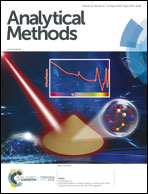Sodium Dichloroisocyanurate Molecularly Imprinted 2D Photonic Crystal Hydrogel Sensor
IF 2.7
3区 化学
Q2 CHEMISTRY, ANALYTICAL
引用次数: 0
Abstract
Sodium dichloroisocyanurate (SDIC) is an efficient, safe and convenient halogen disinfectant, which is widely used in hospital disinfection, tableware disinfection and swimming pool disinfection. In order to ensure the use effect and safety, especially in clinical use, it is necessary to carry out effective identification. The effective chlorine content is one of the quality standards for chlorine-containing disinfectants, but its complex experimental operation, poor specificity and portability limit its application. In contrast, testing based on molecularly imprinted photonic crystals sensors provide excellent performance. Therefore, it is of great significance to establish a new and simple SDIC recognition method. We prepared a novel molecularly imprinted two-dimensional (2D) photonic crystal hydrogel (MIPH) for sensitive and label-free recognition of SDIC. The response performance of the resultant MIPH sensor was determined by monitoring the particle spacing changes of the polystyrene (PS) 2D photonic crystal embedded in the hydrogel. The particle spacing changes can be acquired by measuring the diameter changes of the Debye diffraction ring of the MIPH sensor. As the concentration of SDIC in solution increased from 1×10-2 to 1.0 mmol/L, the diameter of Debye diffraction ring increased by 6 mm, and the corresponding photonic crystal particle spacing decreased by 56 nm. The particle spacing change of the MIPH sensor was linear to the SCDI concentration in the range of 1×10-2 to 1.0 mmol/L and the limit of detection (S/N=3) was found to be 3×10-3 mmol/L. The constructed hydrogel sensor was successfully used to detect SDIC in sodium dichloroisocyanurate disinfectant powder with recoveries of 96-100% and RSDs of 7.2-7.6%. Our molecularly imprinted SDIC photonic crystal hydrogels provide a universal strategy for designing other clinical disinfectants sensors.二氯异氰尿酸钠分子印迹二维光子晶体水凝胶传感器
二氯异氰尿酸钠(SDIC)是一种高效、安全、方便的卤素消毒剂,广泛应用于医院消毒、餐具消毒和游泳池消毒。为了保证使用效果和安全性,特别是在临床使用中,必须进行有效鉴定。有效氯含量是含氯消毒剂的质量标准之一,但其实验操作复杂、特异性差、便携性差,限制了其应用。相比之下,基于分子印迹光子晶体传感器的检测具有优异的性能。因此,建立一种新型、简便的 SDIC 识别方法具有重要意义。我们制备了一种新型分子印迹二维(2D)光子晶体水凝胶(MIPH),用于灵敏、无标记地识别 SDIC。通过监测嵌入水凝胶中的聚苯乙烯(PS)二维光子晶体的粒子间距变化,确定了所制备的 MIPH 传感器的响应性能。粒子间距的变化可以通过测量 MIPH 传感器的德拜衍射环的直径变化来获得。当溶液中的 SDIC 浓度从 1×10-2 增加到 1.0 mmol/L 时,德拜衍射环的直径增加了 6 mm,相应的光子晶体颗粒间距减少了 56 nm。在 1×10-2 至 1.0 mmol/L 的范围内,MIPH 传感器的粒子间距变化与 SCDI 浓度呈线性关系,检测限(S/N=3)为 3×10-3 mmol/L。所构建的水凝胶传感器成功用于检测二氯异氰尿酸钠消毒剂粉末中的 SDIC,回收率为 96-100%,RSD 为 7.2-7.6%。我们的分子印迹 SDIC 光子晶体水凝胶为设计其他临床消毒剂传感器提供了一种通用策略。
本文章由计算机程序翻译,如有差异,请以英文原文为准。
求助全文
约1分钟内获得全文
求助全文
来源期刊

Analytical Methods
CHEMISTRY, ANALYTICAL-FOOD SCIENCE & TECHNOLOGY
CiteScore
5.10
自引率
3.20%
发文量
569
审稿时长
1.8 months
期刊介绍:
Early applied demonstrations of new analytical methods with clear societal impact
 求助内容:
求助内容: 应助结果提醒方式:
应助结果提醒方式:


